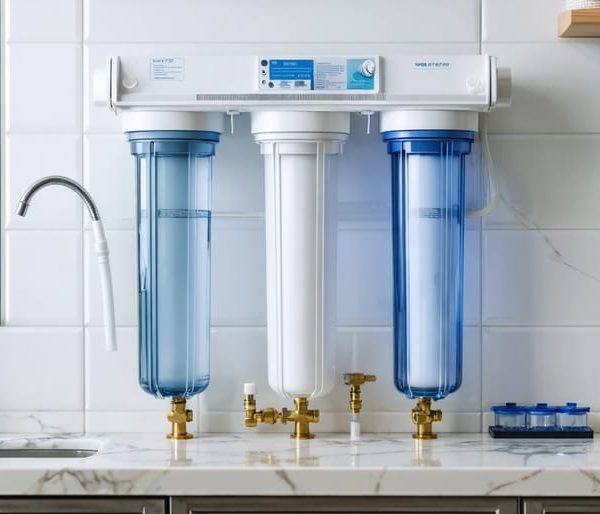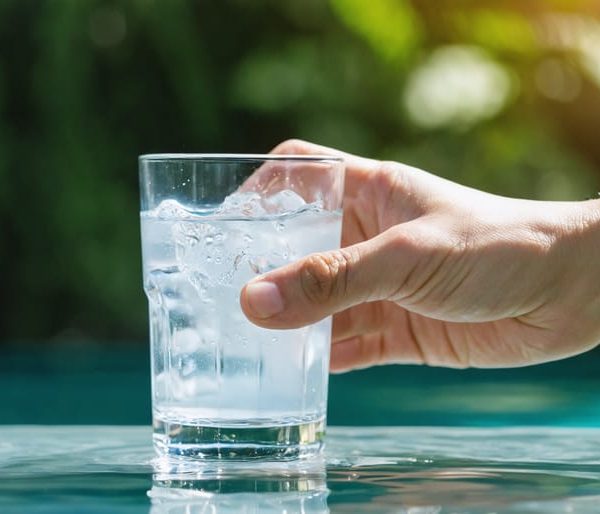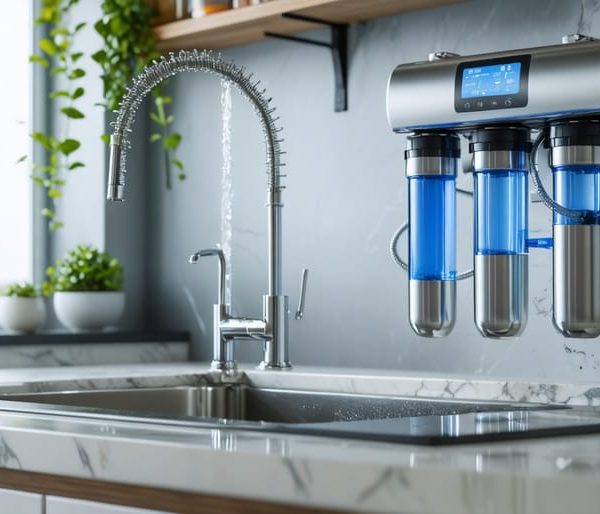UV water filters work by targeting waterborne microorganisms that make water unsafe for consumption. The process is natural and is effective against 99.99% of all living pathogens. Stubborn microbes like Giardia which other methods cannot treat, do not stand a chance against UV light.
The system can work with running water or from a storage tank. Among other advantages, UV purifiers ensure you get safe drinking water all year round. Apart from home use, campers and bikers can carry a portable UV system to guarantee clean water for drinking.
Most UV systems come standardized. To effectively use the system, you need to do a home water analysis. The report will inform you which pathogens are in the water and what UV intensity you require to kill them.
To fully understand how a UV water filter works, let’s take a look at the components first.
Components of a UV Water Purifier

A typical UV water purification system will have four main components:
UV Lamp
The primary function of UV lamps is to emit UV radiation. The radiations are calibrated to target and attack all pathogens. The UV bulb contains a filament that radiates a current that is useful in heating mercury vapor. The mercury is contained in small beads found inside the UV lamp. On heating, it evaporates, producing UV rays.
The Reactor Chamber
It houses the UV light bulb. It also controls the flow of water through the UV system. The reactor chamber will determine the size and shape of UV systems.
Quartz Sleeve
This component holds the UV lamp in place. During operation, the UV lamp is surrounded by contaminated water. The quartz sleeves protect the lamp, ensuring ease of access for maintenance and guaranteeing a longer lifespan.
Controller Unit
It acts as the brain of the UV system. Manufacturers embed different functionalities in this unit which determines the overall cost of the system.
UV Disinfection and Microorganisms
A UV water filter system kills pathogens in about 10 seconds. The effectiveness will depend on the distance the UV rays travel to reach the pathogens.
UV light can effectively kill most bacteria, protozoa, and viruses. Microorganisms like giardia offer resistance to lower intensity UV light. Therefore, it is important first to find out what type of pathogens are in your water through a lab test. Depending on the test, you will choose an effective UV filter.
A UV purifier targets and eliminates living microorganisms from your water supply. It guarantees an extremely high percentage (99.99%) of killing harmful microorganisms. Some of the common organisms eliminated by UV treatment are:
- Hepatitis B
- E. coli
- Algae and Fungi
- Mycobacterium tuberculosis
- Dysentery bacilli
- Cryptosporidium Typhoid Fever
- Salmonella
- Viruses
- Giardia
- Flu
Some of these pathogens are famous for causing life-threatening conditions. It is prudent to install a UV system to protect yourself.
Maintaining a UV System
After installation, a UV water filter does not require constant maintenance. Maintaining a UV purifier is critical. After 9,000 hours of use, the system can become ineffective. Replacing the lamp is the only sure way to keep the system working.
Replacing the UV lamp
It is recommended to change a UV lamp after 375 days of continuous usage. During usage, the mercury vapor continually dissipates. Once the mercury is used up, the system will strain to sterilize your water, leading to a breakdown.
Replacing the quartz sleeve every two to three years. Quartz sleeves lose their transparency after years of usage. It is also prudent to have an extra sleeve in case of damage to the sleeve in use.
Standard UV purifiers come with an alarm. The alarm goes off once the system is unable to kill pathogens effectively. It is a nice feature that reminds users when the filter is no longer effective and the UV lamp requires replacement.
Cleaning
When changing the UV lamp, ensure to clean the quartz sleeve. A dirty quartz sleeve will prevent the effective dissipation of UV radiation.
Pros and Cons
UV Water Purification Advantages
- UV water purification kills bacteria and viruses in water with 99.99% effectiveness.
- You do not have to constantly test your water supply because you are sure the UV water purification process is active for at least 9000 hours.
- UV water filtration is a great alternative to chlorine-based systems. It does not add any chemicals, wastewater or release any waste products into the environment.
- UV water purifiers only need little electricity to complete the water purification process.
- Base models do not require a lot of initial investment. For maintenance, you only need to replace the lamp once per year and the sleeves after two years.
- UV treatment does not require the use of harmful chemicals to kill bacteria.
- UV filters water quickly without affecting the water flow rate. The system does not require a storage tank.
UV Water Purification Disadvantages
- A UV filter is only limited to eliminating living microorganisms. The UV system cannot deal with other contaminants such as heavy metals, pesticides, and other harmful chemicals. You need to combine a UV purifier with other processes to eliminate these other contaminants.
- No change in taste or odor of the water. UV water purifiers do not alter the taste or the odor of the water. You will need to combine your UV water filter with a carbon filter or reverse osmosis system to achieve this.
- A UV water purifier requires electricity to work. It may not be useful in rural or emergencies.
UV disinfection only works in clear waters. If the water is muddied or contains many floating impurities, ultraviolet light will not work against the microbes in the water.
Our Final Thoughts
It is necessary to treat your water before subjecting it to UV treatment. A UV water treatment system does not filter out contaminants such as debris, pesticides, and industrial chemicals. To strike a reliable balance, combine UV filters with carbon or whole house filter method for increased effectiveness.
However, UV light water disinfection is undeniably an effective way to deal with pathogens. It leaves your water clear of microorganisms that, if left unattended, could result in undesirable health consequences.
UV purifiers are inexpensive and do not require a great deal of maintenance. You can make the installation a DIY project or ask a professional to help.



